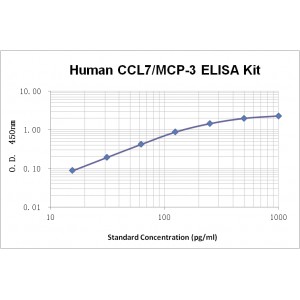More info
Assay Range | 15.6--1000 pg/mL |
Sensitivity | 1.0 pg/mL |
Specificity | No cross-reaction with other related substances detected |
Size | 96T |
Storage | Store at 2 - 8ºC. Keep reconstituted standard and detection Ab at -20 ºC |
Assay Principle | Sandwich ELISA |
Sample Volume | 100 µL final volume, dilution factor varies on samples |
Sample Type | serum, plasma or cell culture supernatant |
Detection Method | Chromogenic |
Kit Components
1. Recombinant Human CCL7 standard: 2 vials
2. One 96-well plate coated with Human CCL7 Ab
3. Sample diluent buffer: 12 mL - 1
4. Detection antibody: 130 µL, dilution 1:100
5. Streptavidin-HRP: 130 µL, dilution 1:100
6. Antibody diluent buffer: 12 mL x1
7. Streptavidin-HRP diluent buffer: 12 mL x1
8. TMB developing agent: 10 mL x1
9. Stop solution: 10 mL x1
10. Washing solution (20x): 25 mL x1
Background
Monocyte Chemotactic Protein-3 (MCP-3), also known as CCL7, NC28, or small-inducible cytokine A7, is a small protein belonging to the CC chemokine family. The MCP-3 cDNA encodes a 99 amino acid (aa) precursor protein with a 23 aa signal peptide and a 76 aa mature protein. Expression of MCP-3 mRNA is constitutive in platelets and is inducible in response to inflammatory cytokines in monocytes, mononuclear cells, fibroblasts, endothelial cells, airway smooth muscle cells (ASMCs), THP-1 myelomonocytic leukemia cells, MG-63 osteosarcoma cells, and U937 promonocytic leukemia cells.
MCP-3 binds to several CC chemokine receptors CCR1, CCR2A, CCR2B, CCR3, and CCR5. In addition to binding MCP-3, however, CCR2A, CCR3, and CCR5 are co-receptors for HIV-1 entry. It is reported that Low concentrations of MCP-3 inhibit, or partially inhibit, HIV-1 infection, while higher concentrations enhance viral replication, indicating that there is complicated interactions among MCP-3, CCR2A, CCR3, and CCR5. MCP-3 is a pluripotent chemokine and plays chemoattractic roles in many different types of immune cells.


